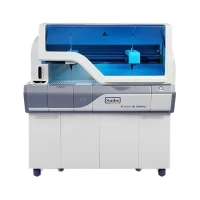
Snibe Maglumi 2000 Chemiluminescence Immunoassay Analyzer
The Snibe Maglumi 2000 is a chemiluminescence immunoassay (CLIA) analyzer used in clinical laboratories for the detection and quantification of various biomarkers in biological samples.
Key Features:
1. Chemiluminescence Detection:
- Principle: Utilizes chemiluminescence to detect and measure the presence of specific analytes. In this method, a chemical reaction produces light, which is then quantified to specify the concentration of the target substance.
2. High Throughput:
- Sample Processing: Capable of processing a large number of samples quickly, making it convenient for high-volume testing environments.
- Automation: Offers automation of sample handling and assay processes, which improves efficiency and lowers manual errors.
3. Versatile Assay Menu:
- Broad Range: Supports a wide variety of assays for different biomarkers, including hormones, tumour markers, cardiac markers, infectious disease markers, and other clinical analytes.
- Test Flexibility: This can be used for both routine and specialized tests, depending on the needs of the laboratory.
4. Advanced Technology:
- Optical System: Features a strong optical system for precise measurement of light emitted during the chemiluminescence reaction.
- Software Integration: Provided with advanced software for result interpretation, quality control, and data management. Delivers user-friendly interfaces and robust data handling capabilities.
5. Accuracy and Sensitivity:
- Precision: Shows high sensitivity and specificity for detecting low levels of analytes, ensuring accurate and reliable results.
- Calibration: Includes calibration and validation features to maintain accuracy over time.
6. User Interface:
- Touchscreen Display: Usually includes a touchscreen interface for easy operation and navigation through the various functions and settings.
- Data Management: Keeps data storage, retrieval, and export, often with options for integration with laboratory information systems (LIS) for seamless data management.
7. Quality Control:
Includes built-in quality control functions to assure the accuracy and reliability of test results This may involve automated calibration, validation checks, and error detection.
Applications:
1. Diagnostic Testing:
- Hormone Testing: Used for estimating hormone levels, such as thyroid hormones, reproductive hormones, and adrenal hormones.
- Tumor Markers: Assesses biomarkers associated with cancer, aiding in diagnosis, prognosis, and monitoring of cancer patients.
2. Cardiac Biomarkers:
- Heart Disease: Measures markers related to heart conditions, such as troponin, BNP, and other cardiac-specific biomarkers.
3. Infectious Disease:
- Pathogen Detection: Helps in diagnosing infectious diseases by detecting specific antibodies or antigens in blood samples.
4. Routine Laboratory Testing:
- Comprehensive Assays: Provides a wide range of assays for general clinical diagnostics and monitoring of patient health.
Advantages:
1. High Efficiency: Offers fast and efficient processing of samples, which is essential for high-throughput laboratories.
2. Versatility: Capable of performing a wide range of tests on different biomarkers, making it a valuable tool for comprehensive diagnostic testing.
3. Automation: Decreases manual intervention and potential errors, enhancing overall accuracy and reliability.
